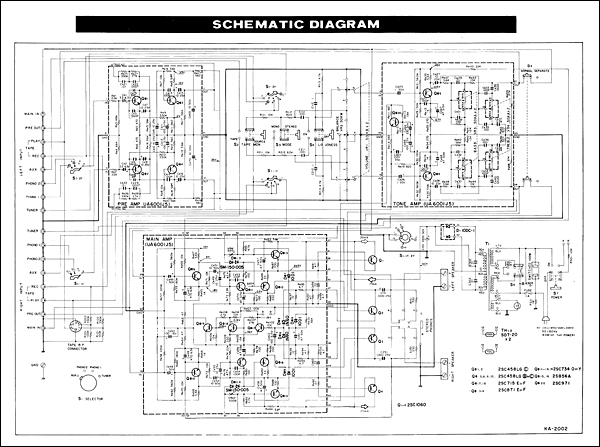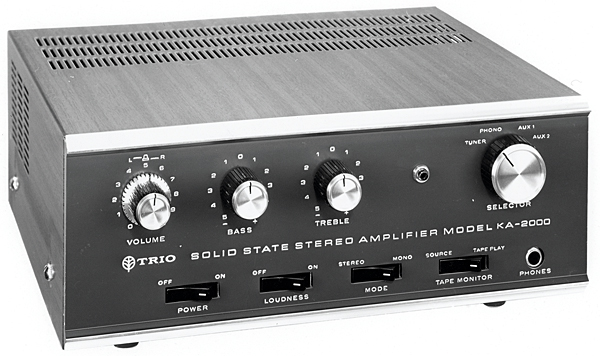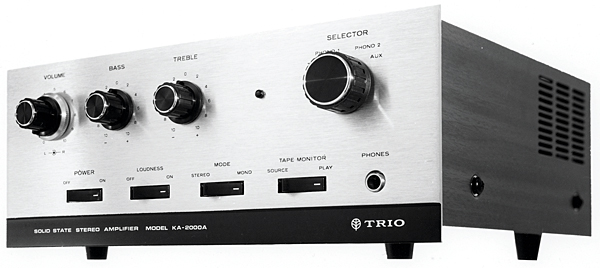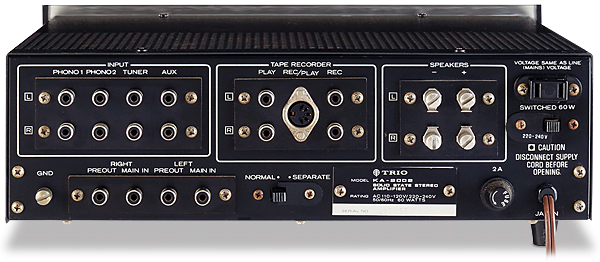Trio/Kenwood KA-2002 Integrated Amplifier Page 2
![]() Tim Listens
Tim Listens
In practice the KA-2002 is light on bass, though this may be ameliorated by the use of ported loudspeakers pushed well into the corners of the listening room. Yet what one gains in bass level one tends to lose in precision, so this is not the perfect solution. With a more conventional set-up, however, the KA-2002 manages to give a good sense of bass. The result is a sound which, after just a few pieces of music have been played, is easy to tune into and enjoy.
Cream Of The Crop
Indeed, there is much to like about the KA-2002, my favourite aspect being its modern feeling and character. Using the line-level inputs (tape, tuner and auxiliary are all the same) it is subjectively noiseless at any volume setting and rewards with a focused, agile sound. Yet the lack of extension at the bottom and top ends, and the prominent midrange this effect generates, means that the KA-2002 never escapes from the 'small amplifier sound', which was ever present during an entire week spent listening to a wide range of material.
Power levels were adequate though, in part because music lacking a hefty bassline can sound strident when played very loudly – an effect that occurs well before any obvious clipping or compression sets in – and this certainly wasn't the case here.

Peter Gabriel's 'Mercy Street' on the compilation Shaking The Tree: Sixteen Golden Greats [Virgin PGTVD 6] sounded impressively spacious and broad through this amplifier. The delicate percussion may have lacked some sparkle, but the centre presence of the vocal was excellent while the bass was tight and tuneful. Detail rendering reached a high standard too, there being no suggestion of the blurring and veiling that some basic amplifiers can cause. 'Grown up' was the phrase that came to my mind. I could see this amplifier remaining useful to its original owner as both sources and loudspeakers were upgraded, perhaps several times.
Largescale orchestral works proved to be more of a challenge, however. The 'Waltz Of The Flowers' from Tchaikovsky's The Nutcracker [Philips 814 125-2] showed promise at first, the opening harp set against a perfectly still background being followed by the most beautifully creamy woodwind. It was the strings that revealed the KA-2002's limitations, sounding a little lifeless and grey when compared to the results given by more sophisticated (and expensive) equipment.
In the end, it is only in its limited ability to convey scale where this neat little unit falls short. Otherwise, it is a pretty good listen. It may not be the best amplifier I've ever heard, but the KA-2002 is still one I'd happily use in a small system.


The DC-coupled generation that came afterwards may have done a better job, but consider this: our well used example is, as far as I can determine, completely original. Not a single component has been replaced and not one connection has been remade since it was built. It is Methuselah with tone controls!
Buying Secondhand
The famous reliability of the Trio/Kenwod KA-2002 has endured to the present day and any reasonably well cared for example is likely to still be fully functional. The designers' protective measures do not rely on relays, so this frequent source of problems when it comes to amplifiers is not an issue here. Nor is there the requirement to adjust the offset voltage in the output stage, for this is stabilised automatically. The only adjustment possible is to set the bias current, which should be 20mA in each channel. With age it tends to fall, resulting in obvious distortion at low volume settings.

Point Of Contact
Component quality is high, so the routine replacement of things such as electrolytic capacitors is unnecessary. One occasionally encounters a sample with excess noise on one of the channels, and this is normally the result of a defective transistor in the small signal stages. Otherwise, most problems stem from tarnished switch contacts, most commonly in lesser used controls. A small dose of contact cleaner is usually all that it required, not forgetting the pre/power amp link switch at the back. This may never have been moved since the amplifier was made!
Hi-Fi News Verdict
An amplifier with genuine vintage interest that sounds good, is easy to use and seldom goes wrong. A dream come true? In a way. The KA-2002 is the perfect introduction to vintage hi-fi, just as it was to everyday serious listening when new. Still abundant and inexpensive, it has so much to recommend it. Be selective as there are a lot of them out there, so don't settle for anything but the very best.


















































